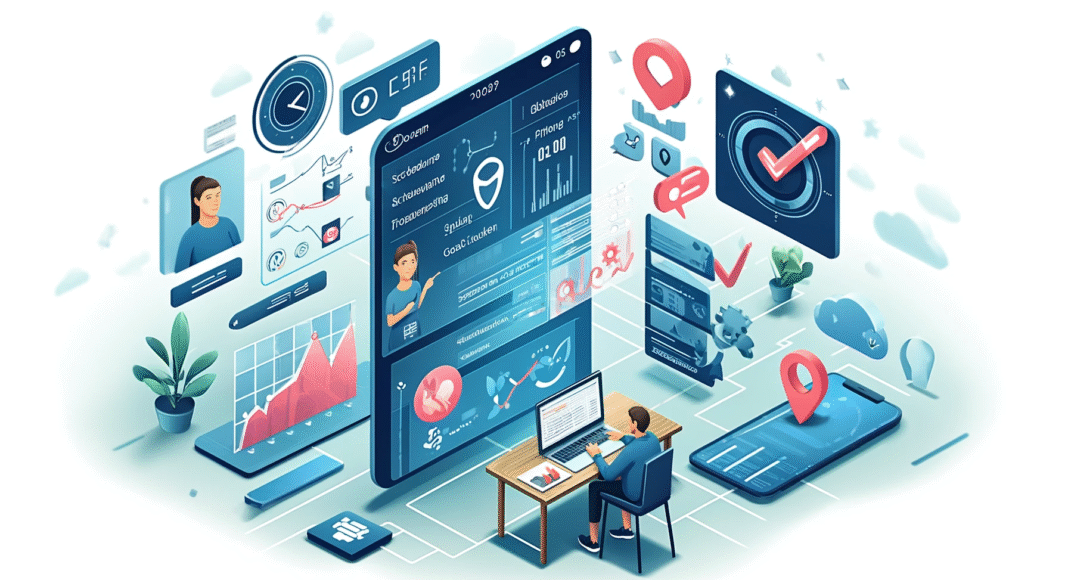Key Takeaways
- Coaching software streamlines coaching processes by automating scheduling, client management, goal tracking, and performance analysis.
- AI-driven and cloud-based solutions enhance coaching efficiency, providing personalized learning paths, real-time feedback, and scalability.
- Businesses, independent coaches, and organizations benefit from data-driven insights, improving engagement, productivity, and coaching effectiveness.
In today’s fast-paced digital world, coaching has evolved beyond traditional in-person sessions to incorporate cutting-edge technology that enhances the coaching experience for both coaches and clients.
As organizations, professionals, and individuals seek more structured and data-driven approaches to personal and professional development, coaching software has emerged as an essential tool in modern coaching practices.
Whether it is career coaching, executive leadership training, life coaching, or fitness guidance, technology-driven coaching platforms are revolutionizing how coaches interact with clients, track progress, and deliver results.

The Growing Demand for Coaching Software
With the increasing emphasis on personal development, career growth, and workplace performance, the coaching industry has experienced rapid expansion.
According to market research, the global coaching industry is valued at billions of dollars, with demand rising across various sectors, including corporate leadership, wellness, education, and entrepreneurship.
However, managing multiple clients, scheduling sessions, tracking progress, and ensuring measurable outcomes can be challenging for coaches.
This is where coaching software steps in, providing a centralized platform to streamline coaching workflows, automate administrative tasks, and facilitate seamless communication between coaches and clients.
Organizations and professionals are now leveraging coaching software to ensure a structured and data-driven approach to coaching, eliminating the inefficiencies of manual record-keeping and scattered communication.
With advancements in artificial intelligence, data analytics, and automation, coaching software is transforming coaching from a one-size-fits-all approach into a personalized and results-oriented process.
What is Coaching Software and Why Does It Matter?
Coaching software is a digital solution designed to help coaches, mentors, and training professionals manage their coaching programs more efficiently. It integrates various tools such as session scheduling, goal tracking, progress monitoring, client communication, data analytics, and resource sharing into a single, user-friendly platform. By utilizing coaching software, coaches can optimize their time, focus on delivering value-driven coaching, and enhance the overall client experience.
This software is particularly beneficial for corporate coaching programs, where companies invest in leadership training, performance development, and employee wellness initiatives. It also plays a significant role in life coaching, helping individuals set and achieve personal goals in areas such as career advancement, financial planning, and mental well-being. Additionally, coaching software is widely used in the health and fitness industry, where trainers and wellness coaches use technology to monitor their clients’ progress and provide customized workout or nutrition plans.
Key Reasons Why Coaching Software is Transforming the Coaching Industry
- Increased Efficiency and Automation
- Automates time-consuming tasks such as appointment scheduling, reminders, and follow-ups.
- Reduces paperwork and manual record-keeping, allowing coaches to focus on client engagement.
- Enhanced Client Engagement and Experience
- Provides clients with structured goal-setting tools and interactive dashboards.
- Allows real-time communication through messaging, video conferencing, and email integration.
- Data-Driven Coaching for Better Results
- Tracks client progress using performance analytics and visual reports.
- Helps coaches measure the effectiveness of coaching strategies and refine their approaches.
- Scalability and Remote Accessibility
- Enables coaches to manage multiple clients seamlessly, regardless of location.
- Supports remote coaching, making it convenient for both coaches and clients to connect virtually.
- Integration with Other Tools
- Syncs with CRM systems, payment gateways, learning management systems (LMS), and other business applications.
- Ensures a seamless workflow by integrating with calendar apps and communication platforms.
Why Businesses and Professionals Should Consider Coaching Software
In a competitive professional landscape, coaching is no longer a luxury but a necessity for career growth, skill enhancement, and leadership development. Businesses are investing in coaching programs to improve employee performance, boost productivity, and enhance workplace satisfaction. Meanwhile, individuals are turning to coaching for personal development, career transitions, and self-improvement.
With the help of coaching software, businesses can implement structured coaching initiatives that align with organizational goals, track employee progress, and measure return on investment. Independent coaches and small coaching businesses can also scale their services more effectively by leveraging technology to reach a wider audience, offer online coaching sessions, and provide personalized coaching experiences.
The Future of Coaching Software: A Tech-Driven Approach to Coaching Success
As coaching continues to evolve, the future of coaching software looks promising, with artificial intelligence (AI), machine learning, and automation playing a key role in shaping the coaching landscape. AI-powered coaching tools are enhancing personalization by analyzing client behavior, predicting challenges, and providing tailored coaching recommendations. Moreover, virtual reality (VR) and augmented reality (AR) are expected to bring immersive coaching experiences, particularly in leadership training, wellness programs, and skill-based learning.
Coaching software is not just a tool—it is a transformative solution that empowers coaches to deliver more effective, structured, and impactful coaching experiences. Whether you are a corporate leader, a business coach, a life coach, or a fitness trainer, investing in the right coaching software can significantly enhance the way you guide, support, and mentor clients toward achieving their goals.
In the following sections, we will explore in-depth how coaching software works, its essential features, benefits, challenges, and the top coaching software solutions available in 2024 to help you make an informed decision.
Before we venture further into this article, we would like to share who we are and what we do.
About 9cv9
9cv9 is a business tech startup based in Singapore and Asia, with a strong presence all over the world.
With over nine years of startup and business experience, and being highly involved in connecting with thousands of companies and startups, the 9cv9 team has listed some important learning points in this overview of What is Coaching Software and How It Works.
If your company needs recruitment and headhunting services to hire top-quality employees, you can use 9cv9 headhunting and recruitment services to hire top talents and candidates. Find out more here, or send over an email to [email protected].
Or just post 1 free job posting here at 9cv9 Hiring Portal in under 10 minutes.
What is Coaching Software and How It Works
- What is Coaching Software?
- Key Features of Coaching Software
- How Coaching Software Works
- Types of Coaching Software
- Benefits of Using Coaching Software
- Challenges and Limitations of Coaching Software
- How to Choose the Right Coaching Software
- Future Trends in Coaching Software
1. What is Coaching Software?
Coaching software is a digital platform designed to help coaches, mentors, trainers, and organizations streamline the coaching process, manage client interactions, and track progress efficiently. It integrates various tools such as goal setting, progress tracking, communication, scheduling, reporting, and resource sharing into a single, user-friendly interface.
This software is used across multiple industries, including corporate coaching, life coaching, health and wellness coaching, executive training, and education. Whether used by independent coaches, coaching firms, or enterprises investing in employee development, coaching software provides a structured, scalable, and data-driven approach to personal and professional growth.
Key Features of Coaching Software
Coaching software is equipped with several core functionalities that enhance the coaching experience for both coaches and clients.
1. Goal Setting and Progress Tracking
- Enables clients to define short-term and long-term goals.
- Provides goal-tracking dashboards with visual progress indicators.
- Allows coaches to set milestones, deadlines, and action plans for clients.
- Example: CoachAccountable offers structured goal-setting tools with automated progress tracking and reporting.
2. Session Scheduling and Calendar Integration
- Automates appointment booking and scheduling.
- Integrates with Google Calendar, Outlook, and other calendar apps.
- Sends automated reminders and notifications to clients and coaches.
- Example: Simply.Coach provides a seamless scheduling system with automatic time zone adjustments for international clients.
3. Communication and Engagement Tools
- Supports video conferencing, chat, and email integration.
- Enables real-time messaging and file-sharing capabilities.
- Offers discussion forums and group coaching features.
- Example: Coaching.com integrates with Zoom and Microsoft Teams for remote coaching sessions.
4. Client Management and Data Organization
- Stores client profiles, history, and session notes in a secure database.
- Centralizes all coaching interactions and documents in one place.
- Allows coaches to categorize clients based on coaching type, goals, and progress.
- Example: Delenta provides a centralized dashboard for managing client profiles and session history.
5. Performance Analytics and Reporting
- Generates reports on client progress, session effectiveness, and goal completion.
- Uses data analytics to identify trends and coaching impact.
- Helps coaches refine their coaching strategies based on measurable outcomes.
- Example: CoachAccountable offers detailed analytics to track coaching effectiveness over time.
6. Content and Resource Management
- Enables coaches to upload and share coaching materials such as PDFs, videos, and worksheets.
- Provides a structured library of resources for clients.
- Supports interactive learning modules and self-paced training content.
- Example: Mighty Networks allows coaches to create exclusive content libraries and online communities.
7. Payment and Billing Integration
- Automates invoicing and payment processing.
- Supports multiple payment gateways such as PayPal, Stripe, and credit cards.
- Allows coaches to set up subscription-based or one-time payment plans.
- Example: Paperbell automates coaching package payments and session tracking.
8. Multi-Coach and Team Collaboration Features
- Enables coaching firms to manage multiple coaches under one platform.
- Allows coaches to collaborate on client progress and share insights.
- Supports team-based coaching with role-based permissions.
- Example: Coaching Loft provides multi-coach management and collaboration tools for coaching firms.
Types of Coaching Software
Different types of coaching software cater to various coaching needs, industries, and methodologies.
1. Corporate and Executive Coaching Software
- Designed for businesses investing in leadership development and employee coaching.
- Helps HR teams and managers track employee progress and performance.
- Example: BetterUp offers AI-driven executive coaching for professional development.
2. Life Coaching Software
- Supports life coaches in guiding clients through personal growth and self-improvement.
- Includes goal-setting tools, habit trackers, and mindfulness resources.
- Example: Quenza provides behavioral change tools for life coaching.
3. Health and Wellness Coaching Software
- Used by fitness trainers, dietitians, and health coaches to monitor client wellness.
- Integrates with wearable devices to track fitness progress.
- Example: My PT Hub enables trainers to create workout and nutrition plans.
4. Educational and Student Coaching Software
- Helps academic coaches guide students through learning strategies and career planning.
- Includes study tracking, mentorship programs, and online learning tools.
- Example: CoachVantage offers student success coaching solutions.
Benefits of Using Coaching Software
Coaching software enhances coaching efficiency and improves client outcomes through structured, data-driven coaching methodologies.
1. Saves Time and Enhances Productivity
- Automates administrative tasks like scheduling, reminders, and payment processing.
- Allows coaches to focus on providing value-driven coaching rather than manual work.
2. Improves Client Engagement and Retention
- Enhances the coaching experience with interactive tools and seamless communication.
- Keeps clients motivated with visual progress trackers and milestone achievements.
3. Increases Coaching Scalability
- Enables coaches to manage more clients efficiently.
- Supports group coaching and online courses for scalable coaching models.
4. Provides Data-Driven Insights
- Helps coaches refine their strategies based on performance analytics.
- Ensures measurable coaching success through tracked progress and reports.
5. Enables Remote and Global Coaching
- Supports virtual coaching sessions through integrated video conferencing.
- Allows coaches to work with clients across different time zones and locations.
Final Thoughts on Coaching Software
Coaching software is an essential tool for modern coaches looking to enhance efficiency, improve client engagement, and deliver measurable results. Whether used by corporate organizations, independent coaches, or training institutions, this software offers a structured and technology-driven approach to coaching. As AI and automation continue to evolve, coaching platforms will further advance, offering more personalized and intelligent coaching experiences for clients worldwide.
2. Key Features of Coaching Software
Coaching software is equipped with a wide range of features that help coaches manage client interactions, streamline workflows, and improve the effectiveness of coaching programs. These features enhance productivity, automate administrative tasks, and provide a seamless experience for both coaches and clients.
Below are the key features of coaching software, along with relevant examples where applicable.
1. Goal Setting and Progress Tracking
Effective coaching is goal-driven, and coaching software provides structured tools to define, track, and measure client progress.
- Allows coaches to set short-term and long-term goals for clients.
- Offers customizable goal templates based on different coaching specializations (e.g., leadership, wellness, career development).
- Tracks client progress through visual dashboards, graphs, and progress bars.
- Provides reminders and notifications to ensure clients stay on track.
- Enables coaches to adjust coaching plans dynamically based on client progress.
- Example: CoachAccountable provides automated goal-setting, real-time tracking, and progress reports to help clients stay motivated.
2. Session Scheduling and Calendar Management
Coaching software eliminates the hassle of scheduling and rescheduling sessions manually.
- Automates appointment booking and session management.
- Integrates with Google Calendar, Outlook, and Apple Calendar for seamless scheduling.
- Provides real-time availability tracking, ensuring clients can book available slots.
- Sends automated reminders and notifications to reduce no-shows.
- Supports time zone synchronization, enabling international coaching sessions.
- Offers one-on-one, group, and recurring session scheduling options.
- Example: Simply.Coach provides smart scheduling and automated session reminders to keep coaches and clients on track.
3. Secure Communication and Collaboration Tools
Effective communication is essential for successful coaching, and coaching software includes multiple collaboration features.
- Supports secure messaging, chat, and email between coaches and clients.
- Offers video conferencing and live coaching sessions through integrations with Zoom, Microsoft Teams, or built-in platforms.
- Enables session recording and transcription, allowing clients to revisit coaching discussions.
- Allows document and resource sharing, including worksheets, guides, and eBooks.
- Facilitates group coaching and discussion forums for peer learning.
- Example: Coaching.com integrates seamlessly with Zoom and Microsoft Teams, providing an all-in-one coaching communication platform.
4. Client Relationship Management (CRM)
A built-in CRM system helps coaches keep track of client interactions and progress.
- Stores client profiles, coaching history, and session notes in one place.
- Allows segmentation of clients based on coaching programs, progress levels, or coaching goals.
- Provides a centralized database to access client information quickly.
- Supports automated follow-ups and reminders to maintain engagement.
- Enhances personalization by offering customized coaching plans based on client history.
- Example: Delenta provides an integrated CRM that helps coaches track client interactions and coaching progress efficiently.
5. Performance Analytics and Reporting
Coaching software offers data-driven insights that help coaches measure their impact.
- Generates automated reports on client progress, engagement levels, and session attendance.
- Uses AI-powered analytics to identify patterns and recommend improvements.
- Provides coaching effectiveness metrics to evaluate the success of coaching programs.
- Helps coaches adjust strategies based on performance data.
- Supports customizable reports that can be shared with clients for transparency.
- Example: CoachAccountable offers built-in analytics to measure coaching success and optimize coaching methodologies.
6. Content and Resource Management
A well-organized resource library enhances the learning experience for clients.
- Allows coaches to upload and share content such as PDFs, videos, worksheets, and guides.
- Provides structured learning modules with step-by-step coaching materials.
- Supports interactive learning, including quizzes, self-assessments, and progress evaluations.
- Enables integration with third-party Learning Management Systems (LMS).
- Example: Mighty Networks allows coaches to build a digital library of training materials for clients to access anytime.
7. Payment and Subscription Management
Automated billing and payment processing simplify the financial aspects of coaching.
- Supports one-time payments, subscriptions, and installment plans.
- Automates invoicing and payment reminders to reduce manual effort.
- Integrates with payment gateways like PayPal, Stripe, and credit cards.
- Provides financial tracking tools to monitor revenue and earnings.
- Offers discount and coupon management for special coaching programs.
- Example: Paperbell streamlines client payments and invoicing, making financial management easier for coaches.
8. Multi-Coach and Team Collaboration
For coaching businesses with multiple coaches, team collaboration tools are essential.
- Allows multiple coaches to work under a unified platform.
- Supports role-based permissions, ensuring team members have appropriate access.
- Provides team analytics and performance tracking to measure coaching effectiveness.
- Enables shared resources and templates for consistency in coaching delivery.
- Supports co-branded coaching programs, allowing firms to deliver a unified experience.
- Example: Coaching Loft offers team-based coaching features for firms managing multiple coaches and clients.
9. White-Labeling and Custom Branding
Many coaching businesses prefer a platform that reflects their unique brand identity.
- Allows custom branding, logos, and color schemes.
- Supports white-labeled portals, ensuring a seamless brand experience for clients.
- Enables custom domain integration, allowing coaches to host the platform under their own website.
- Offers personalized dashboards with company-specific branding.
- Example: Simply.Coach provides white-label solutions for coaching businesses to maintain brand consistency.
10. AI-Powered Coaching Assistance
AI-powered coaching features enhance personalization and automation.
- Uses AI-driven recommendations for coaching strategies.
- Automates client progress tracking and suggests adjustments in coaching plans.
- Provides predictive analytics to forecast client challenges and recommend solutions.
- Uses chatbots and virtual assistants for real-time client support.
- Example: BetterUp leverages AI to deliver highly personalized coaching experiences at scale.
11. Compliance and Security Features
Data security and regulatory compliance are crucial for coaching software, especially when dealing with sensitive client information.
- Supports GDPR, HIPAA, and industry-specific compliance to protect client data.
- Provides end-to-end encryption for secure communication.
- Ensures role-based access control, limiting access to authorized users only.
- Offers data backup and recovery solutions to prevent data loss.
- Example: Coaching.com ensures full compliance with global data privacy laws, making it a secure platform for professional coaches.
12. Mobile App Accessibility
Many coaching platforms offer mobile-friendly features to enhance accessibility.
- Provides mobile apps for Android and iOS devices.
- Enables clients to access coaching materials and interact with coaches on the go.
- Supports push notifications for session reminders and coaching updates.
- Ensures seamless synchronization between desktop and mobile versions.
- Example: Quenza offers a mobile app that allows coaches and clients to stay connected anytime, anywhere.
Final Thoughts on Key Features of Coaching Software
The right coaching software offers a comprehensive suite of tools to enhance coaching effectiveness, automate administrative tasks, and provide valuable insights into client progress. From goal tracking and scheduling to AI-powered coaching assistance, these features empower coaches to deliver high-quality, data-driven coaching experiences. Whether you are a life coach, executive coach, wellness coach, or corporate trainer, choosing a platform with these essential features can significantly improve your coaching efficiency and client satisfaction.
3. How Coaching Software Works
Coaching software is designed to streamline coaching processes, enhance client engagement, and automate administrative tasks. It integrates multiple functionalities into a single platform, allowing coaches to manage clients, schedule sessions, track progress, and deliver coaching materials efficiently.
The working mechanism of coaching software involves several key steps, from client onboarding to progress tracking and reporting. Below is a detailed breakdown of how coaching software functions, with relevant examples where applicable.
1. Client Onboarding and Profile Management
Before coaching begins, clients need to be onboarded into the platform, where their information and goals are documented.
- Client Registration:
- Clients sign up through a custom registration portal provided by the coaching software.
- Registration forms can include fields for personal details, coaching objectives, and prior experience.
- Some platforms offer automated intake forms for a structured onboarding experience.
- Profile Creation:
- A personalized dashboard is created for each client, displaying goals, progress, upcoming sessions, and shared resources.
- Clients can upload documents, assessments, or relevant materials to help coaches tailor their approach.
- Example: CoachAccountable offers a structured onboarding process with customizable intake forms to capture essential client details.
2. Goal Setting and Personalized Coaching Plans
Once a client is onboarded, the next step is to define coaching goals and set up a structured plan.
- Goal Definition:
- Coaches and clients collaboratively set SMART (Specific, Measurable, Achievable, Relevant, Time-bound) goals.
- Software provides goal-setting templates to ensure clear objectives.
- Custom Coaching Plans:
- Coaches can create customized coaching pathways based on client needs.
- Software allows coaches to assign specific exercises, self-assessments, or action steps to help clients achieve goals.
- Some platforms use AI-driven insights to suggest adjustments in coaching strategies.
- Example: BetterUp uses AI-powered coaching to personalize plans based on behavioral patterns and client input.
3. Session Scheduling and Calendar Integration
Managing coaching sessions efficiently is a core function of coaching software.
- Automated Scheduling:
- Clients can book coaching sessions directly from the software based on the coach’s availability.
- Integrated calendar syncing with Google Calendar, Outlook, or Apple Calendar ensures no conflicts.
- Time zone synchronization enables global coaching sessions without scheduling confusion.
- Session Reminders & Notifications:
- The system sends automated email or SMS reminders to reduce no-shows.
- Clients receive push notifications for upcoming coaching sessions.
- Rescheduling & Cancellation:
- Clients can reschedule or cancel appointments based on predefined policies set by the coach.
- Some platforms enforce cancellation policies with automated penalty charges for missed sessions.
- Example: Simply.Coach offers AI-powered scheduling to optimize session timing based on engagement analytics.
4. Virtual Coaching and Communication Tools
Most coaching sessions take place virtually, and coaching software provides multiple ways for seamless communication.
- Video Conferencing Integration:
- Platforms integrate with Zoom, Microsoft Teams, Google Meet, or built-in video call systems.
- Session recording features allow clients to revisit discussions at any time.
- Secure Messaging & Chat Features:
- Coaches and clients can exchange messages in real time through in-app chat systems.
- Some platforms use AI chatbots for instant responses to client inquiries.
- Resource & File Sharing:
- Coaches can upload guides, worksheets, videos, and PDFs directly to the client portal.
- Clients can submit assignments, reflections, or progress notes for coach review.
- Example: Coaching.com offers built-in video conferencing and encrypted messaging for secure coach-client interactions.
5. Progress Tracking and Performance Analytics
Coaching software provides real-time insights into client progress, ensuring measurable results.
- Automated Progress Monitoring:
- The platform tracks client milestones and displays progress in graphical dashboards.
- Clients can update their goal completion status after each session.
- Self-Assessments & Feedback Forms:
- Coaches can create interactive self-assessments, reflection forms, or surveys.
- AI-powered platforms analyze client responses and suggest improvements.
- Data-Driven Insights:
- The software generates coaching effectiveness reports using AI and machine learning.
- Performance analytics help coaches refine their approach based on data trends.
- Example: CoachAccountable offers real-time progress tracking with visual analytics to measure coaching impact.
6. Learning Modules and Resource Management
Coaching is not limited to live sessions—many software solutions include learning management features to enhance client engagement.
- Interactive Learning Content:
- Coaches can create multi-step learning modules with video, text, and quizzes.
- Gamification elements, such as badges and achievement tracking, boost motivation.
- On-Demand Resource Access:
- Clients can access pre-recorded sessions, guides, and knowledge bases anytime.
- AI-curated content recommendations provide personalized learning paths.
- Example: Mighty Networks allows coaches to build an extensive content library with structured coaching courses.
7. Payment Processing and Subscription Management
Coaching software simplifies financial transactions and automates billing.
- Payment Gateway Integration:
- Supports PayPal, Stripe, credit cards, and direct bank transfers.
- Clients can set up one-time payments, subscription models, or pay-per-session structures.
- Automated Invoicing & Receipts:
- Generates and emails invoices and payment confirmations automatically.
- Some platforms offer tax calculation and financial reporting tools.
- Discounts & Package Customization:
- Coaches can offer bundled session packages, promotional discounts, or loyalty rewards.
- Example: Paperbell provides automated subscription-based billing and payment tracking.
8. Multi-Coach and Team Collaboration
For businesses with multiple coaches, the software offers tools for team collaboration.
- Team Management Dashboard:
- Assigns clients to different coaches based on specialization.
- Tracks individual coach performance and client feedback.
- Role-Based Access Controls:
- Coaches, admin staff, and managers have different levels of access to coaching materials and client data.
- Example: Coaching Loft offers multi-coach management with shared resources and team analytics.
9. AI and Automation for Enhanced Coaching
Many modern coaching platforms incorporate artificial intelligence to optimize coaching strategies.
- AI-Powered Insights:
- AI suggests personalized coaching techniques based on client engagement and feedback.
- Predictive analytics help anticipate client challenges and recommend solutions.
- Chatbots & Virtual Coaching Assistants:
- AI-driven chatbots answer frequently asked questions and provide support.
- Some platforms offer automated coaching nudges to keep clients engaged.
- Example: BetterUp uses AI to deliver tailored coaching recommendations and insights.
10. Security and Compliance
Ensuring data protection and regulatory compliance is a key aspect of coaching software.
- Data Encryption & Privacy Controls:
- Platforms use end-to-end encryption to protect client data.
- Supports compliance with GDPR, HIPAA, and other data protection laws.
- User Authentication & Access Control:
- Includes multi-factor authentication (MFA) for added security.
- Role-based access ensures only authorized personnel handle sensitive data.
- Example: Simply.Coach prioritizes data security with enterprise-grade encryption and compliance tools.
Final Thoughts on How Coaching Software Works
Coaching software acts as a comprehensive digital ecosystem, supporting coaches in client management, communication, learning, analytics, and financial transactions. From automating administrative workflows to enhancing client engagement, the software makes coaching more efficient and scalable. Whether used by independent coaches or large coaching firms, adopting a robust coaching platform helps streamline operations and improve coaching effectiveness.
4. Types of Coaching Software
Coaching software comes in various types, each designed to support different coaching methodologies, industries, and client engagement models. Whether for life coaching, executive coaching, business coaching, or specialized niches like health and wellness, the right software enhances coaching effectiveness, improves client management, and streamlines administrative tasks.
Below are the main types of coaching software, categorized based on their functionality, use case, and industry relevance, along with relevant examples.
1. General-Purpose Coaching Software
These platforms cater to a broad range of coaching styles, offering a comprehensive set of tools for client management, scheduling, communication, and goal tracking. They are ideal for coaches who work across different disciplines.
- Key Features:
- Client onboarding and profile management
- Session scheduling and calendar integration
- Goal-setting and progress tracking
- Built-in messaging and document sharing
- Billing and payment processing
- Best For:
- Life coaches, executive coaches, career coaches, and business coaches.
- Coaches managing multiple clients with different coaching needs.
- Examples:
- CoachAccountable – Offers a complete suite of coaching tools, including session tracking, goal setting, and automation.
- Simply.Coach – A cloud-based coaching platform with built-in scheduling, note-taking, and client progress tracking.
2. Business and Executive Coaching Software
This type of software is designed for corporate coaching, leadership development, and performance improvementwithin organizations. It helps coaches track employee progress, measure leadership effectiveness, and facilitate executive training programs.
- Key Features:
- Enterprise-level coaching management for organizations.
- Multi-coach collaboration for coaching teams.
- Advanced analytics and reporting for leadership progress tracking.
- AI-powered leadership insights for data-driven decision-making.
- Integration with HR software for employee performance tracking.
- Best For:
- Executive coaches, business consultants, HR departments, and leadership development professionals.
- Organizations looking to enhance leadership training and improve team performance.
- Examples:
- BetterUp – Uses AI-driven coaching insights for leadership and executive coaching programs.
- CoachLogix – An enterprise coaching platform offering real-time coaching analytics and corporate training support.
3. Health and Wellness Coaching Software
This category includes software tailored for fitness, nutrition, mental health, and overall well-being coaching. It integrates tools for tracking physical and mental health metrics, setting wellness goals, and managing personalized health programs.
- Key Features:
- Health goal tracking and personalized coaching plans.
- Integration with fitness trackers and wearable devices (Fitbit, Apple Health, etc.).
- Meal planning and dietary tracking.
- Session booking and automated reminders for fitness coaching.
- Habit-forming and behavior-change tools for wellness improvement.
- Best For:
- Health coaches, fitness trainers, dietitians, mental health coaches, and lifestyle consultants.
- Organizations offering corporate wellness programs.
- Examples:
- Nudge Coach – Designed for health and wellness coaches, offering client engagement and progress tracking tools.
- Coach Catalyst – A fitness coaching software for trainers to manage workout plans, nutrition tracking, and client motivation.
4. Life Coaching Software
Life coaching software focuses on personal development, goal setting, and behavior change. It helps coaches guide clients through self-improvement programs by providing structured coaching sessions and accountability tracking.
- Key Features:
- Customizable goal-setting frameworks.
- Journaling and reflection tools for mindset coaching.
- Habit tracking and self-assessment surveys.
- Personalized coaching pathways and resource libraries.
- Motivational check-ins and AI-driven nudges.
- Best For:
- Life coaches, mindset coaches, personal growth consultants, and transformation coaches.
- Clients seeking personal growth, motivation, and self-improvement guidance.
- Examples:
- Life Coach Hub – Offers a complete suite of tools for life coaches, including worksheets, assessments, and goal tracking.
- Quenza – A psychology-backed coaching platform designed for personal development and habit formation.
5. Career and Job Coaching Software
This software is built for career coaches, resume consultants, and job search mentors who help clients navigate their career paths, job transitions, and skill development.
- Key Features:
- Career goal mapping and action plans.
- Resume and LinkedIn profile optimization tools.
- Mock interview scheduling and feedback tracking.
- Skill assessment and job market insights.
- AI-driven career guidance and job application tracking.
- Best For:
- Career coaches, job placement consultants, and HR professionals.
- Individuals looking for career transitions, job search support, and interview coaching.
- Examples:
- PathwayU – Uses AI-driven career assessments to guide job seekers and professionals.
- MyCoach – Offers career-focused coaching, including job application tracking and professional development tools.
6. Academic and Student Coaching Software
Academic coaching software is designed to support students in academic success, skill-building, and study habit improvement. It helps tutors and academic coaches provide structured learning support.
- Key Features:
- Study plans and academic goal tracking.
- Time management and productivity coaching.
- Learning analytics and student progress reporting.
- Integration with e-learning platforms and student portals.
- Mentorship and virtual tutoring capabilities.
- Best For:
- Academic coaches, student mentors, and educational consultants.
- High school and college students needing study support, time management coaching, and academic planning.
- Examples:
- CoachAccountable – Supports academic coaching with structured goal-setting and learning progress tracking.
- TutorCruncher – A specialized platform for academic coaching and tutoring businesses.
7. Sports Coaching Software
Sports coaching software is specifically developed for athletes, sports teams, and fitness trainers. It enables coaches to analyze performance, create workout plans, and track athlete progress.
- Key Features:
- Training session planning and workout tracking.
- Performance analytics and video review tools.
- Injury tracking and rehabilitation progress monitoring.
- Team management and communication tools.
- AI-powered insights for sports performance optimization.
- Best For:
- Sports coaches, athletic trainers, personal trainers, and team managers.
- Athletes looking for performance tracking and structured training plans.
- Examples:
- Hudl – Offers video analysis and performance tracking for sports teams.
- CoachNow – Provides digital training logs, athlete feedback, and skill assessments.
Final Thoughts on Types of Coaching Software
Coaching software comes in many specialized forms, catering to various coaching disciplines. Whether it is business coaching, life coaching, health coaching, or sports training, the right platform enhances coaching efficiency, improves client engagement, and simplifies administration.
For individual coaches and coaching firms, choosing the right software depends on business goals, coaching methodology, and client needs. Investing in a robust coaching platform ensures scalability, better outcomes, and a more streamlined coaching experience.
5. Benefits of Using Coaching Software
Coaching software has revolutionized how coaches manage clients, deliver personalized sessions, and track progress. Whether for life coaching, executive coaching, business coaching, health coaching, or sports training, coaching platforms provide a structured and scalable way to enhance coaching effectiveness.
By automating administrative tasks, improving client engagement, and leveraging data-driven insights, coaching software helps coaches optimize their workflow while delivering high-impact results. Below are the key benefits of using coaching software, along with relevant examples where applicable.
1. Streamlines Client Management
Managing multiple clients manually can be overwhelming. Coaching software simplifies client onboarding, session scheduling, progress tracking, and communication.
- Client Profiles and History:
- Stores all client information, session notes, goals, and progress reports in one centralized place.
- Enables coaches to review past interactions and customize future coaching sessions.
- Example: CoachAccountable allows coaches to track client milestones and set automated follow-ups.
- Automated Scheduling and Appointment Reminders:
- Eliminates scheduling conflicts with calendar integrations (Google Calendar, Outlook, etc.).
- Sends automated reminders to both coaches and clients, reducing missed sessions.
- Example: Simply.Coach provides an integrated booking system with automated email and SMS reminders.
- Secure Document and Resource Sharing:
- Allows clients to access workbooks, coaching materials, and session recordings in one place.
- Supports secure file sharing and cloud storage.
- Example: Quenza provides a digital library for sharing assignments, PDFs, and personalized coaching pathways.
2. Enhances Client Engagement and Accountability
Client engagement is crucial for successful coaching. Coaching software offers tools to keep clients motivated, accountable, and actively participating in their progress.
- Goal Setting and Progress Tracking:
- Coaches can define SMART goals (Specific, Measurable, Achievable, Relevant, Time-bound) and track completion rates.
- Clients receive visual progress reports and real-time feedback, boosting motivation.
- Example: BetterUp provides AI-driven insights to track leadership development and career progression.
- Automated Check-Ins and Nudges:
- Sends periodic reminders, motivational messages, and progress updates to keep clients on track.
- Helps build positive habits and long-term behavior changes.
- Example: Coach Catalyst sends automated habit reminders for fitness and wellness coaching clients.
- Interactive Communication Channels:
- Built-in chat, video call, and voice messaging improve coach-client interaction.
- Clients can ask questions, share concerns, and receive real-time support.
- Example: Nudge Coach enables group and one-on-one messaging with structured feedback.
3. Saves Time and Reduces Administrative Work
Manual administrative tasks can take up significant coaching time. Coaching software automates repetitive processes, allowing coaches to focus on client development.
- Billing and Payment Automation:
- Supports online invoicing, automated payment collection, and subscription billing.
- Reduces late payments and ensures a steady revenue stream.
- Example: Practice offers built-in Stripe and PayPal integration for seamless billing.
- Session Recording and Note-Taking:
- Coaches can record virtual sessions for later review and reference.
- Built-in note-taking tools help document client progress and session outcomes.
- Example: CoachLogix provides cloud-based session recording and automated note storage.
- Pre-Built Coaching Templates and Frameworks:
- Provides structured coaching plans, worksheets, and self-assessment templates.
- Saves time on content creation while maintaining consistency across coaching programs.
- Example: Life Coach Hub offers a customizable template library for life coaches.
4. Improves Data-Driven Decision Making
Data insights help coaches measure client progress, session effectiveness, and overall coaching impact.
- Analytics and Performance Tracking:
- Provides data dashboards to track client engagement, goal completion rates, and session effectiveness.
- Coaches can adjust strategies based on measurable progress.
- Example: BetterUp uses AI-powered analytics to assess coaching effectiveness in corporate leadership development.
- Client Feedback and Surveys:
- Collects real-time client feedback to assess satisfaction and improve coaching techniques.
- Supports custom surveys and self-assessments.
- Example: Simply.Coach offers built-in feedback loops to measure coaching impact and client satisfaction.
- AI-Powered Insights and Personalized Recommendations:
- Some coaching software solutions leverage AI to provide coaching suggestions, detect client progress trends, and optimize engagement.
- Example: CoachHub offers AI-driven recommendations for personalized coaching journeys.
5. Enhances Scalability for Coaching Businesses
For coaches looking to expand their reach, coaching software allows for scaling business operations without compromising quality.
- Multi-Coach Collaboration:
- Allows coaching firms to manage multiple coaches and clients in one platform.
- Coaches can assign clients to different team members while maintaining seamless collaboration.
- Example: CoachLogix supports multi-coach management with role-based access control.
- Group Coaching and Online Courses:
- Enables group coaching programs, webinars, and online course creation.
- Expands revenue streams through self-paced coaching modules.
- Example: Kajabi allows coaches to monetize online courses and coaching memberships.
- Marketing and Lead Generation Tools:
- Provides landing pages, email automation, and CRM integrations for client acquisition.
- Supports SEO optimization and social media marketing tools.
- Example: Paperbell includes built-in marketing automation for growing a coaching business.
6. Ensures Compliance and Security
Data security and privacy are crucial for client trust. Coaching software ensures that client information is securely stored and compliant with industry regulations.
- GDPR and HIPAA Compliance:
- Protects client data with encrypted communication, secure storage, and regulatory compliance.
- Essential for health coaching and executive coaching within enterprises.
- Example: Quenza ensures GDPR and HIPAA compliance for client data protection.
- Role-Based Access Control:
- Limits access to sensitive data based on coach and client roles.
- Prevents unauthorized access and data breaches.
- Example: CoachAccountable offers advanced user permission settings.
- Confidentiality Agreements and Digital Signatures:
- Supports e-signatures for coaching contracts and confidentiality agreements.
- Ensures legal protection for both coaches and clients.
- Example: Practice includes built-in e-signature functionality for coaching agreements.
Final Thoughts on the Benefits of Coaching Software
Coaching software provides a centralized, scalable, and efficient solution for modern coaching practices. Whether for life coaching, executive coaching, business mentoring, health coaching, or sports training, leveraging technology enhances client engagement, operational efficiency, and business growth.
For coaches, investing in the right coaching platform means less time on administration, more time for impactful coaching, and improved client outcomes. With automated workflows, data-driven insights, and seamless communication, coaching software is an essential tool for any coach looking to elevate their coaching practice.
6. Challenges and Limitations of Coaching Software
While coaching software has transformed how coaches manage clients, deliver sessions, and track progress, it is not without its challenges and limitations. Many coaches and organizations encounter technical, financial, and operational difficulties when implementing and using these platforms.
Understanding the common challenges associated with coaching software can help coaches make informed decisions, choose the right platform, and set realistic expectations. Below are the key challenges and limitations of coaching software, along with relevant examples where applicable.
1. High Initial Costs and Subscription Fees
Many coaching platforms come with subscription fees, setup costs, and premium feature upgrades, which can be a barrier for independent coaches and small businesses.
- Expensive Monthly or Annual Subscriptions:
- Many platforms operate on a monthly or annual subscription model, which can be costly for solo coaches.
- Premium features like AI-driven analytics, automation, and multi-coach management often require higher-tier plans.
- Example: CoachAccountable has a tiered pricing model, with advanced features only available in higher-priced plans.
- Customization and White-Labeling Fees:
- Some coaching software allows customization and branding, but these features often come at an extra cost.
- White-label solutions for coaching businesses can be expensive, limiting accessibility for small-scale coaches.
- Example: Simply.Coach offers white-label branding but only on premium plans.
- Additional Costs for Integrations and Add-ons:
- Coaches may need to purchase additional tools and integrations for CRM, payment processing, or video conferencing.
- Platforms that do not offer built-in tools may require third-party integrations, increasing costs.
- Example: Paperbell requires separate Zoom or Stripe accounts for video sessions and payments.
2. Steep Learning Curve and Technical Complexity
Not all coaches are tech-savvy, and many find it challenging to adapt to coaching software, especially if it has a complex user interface.
- Complicated Setup and Configuration:
- Some coaching software solutions require extensive setup, customization, and integrations, making onboarding difficult.
- Coaches without technical expertise may struggle with platform navigation and optimization.
- Example: Kajabi offers powerful coaching tools but has a complex learning curve, requiring extensive tutorials.
- Limited User Training and Support:
- Some platforms provide minimal training materials, making it hard for new users to understand all functionalities.
- Customer support may not be available 24/7, leading to delays in resolving technical issues.
- Example: Life Coach Hub provides basic user guides but lacks extensive onboarding support.
- Software Updates and Feature Changes:
- Regular updates can change the user interface and workflows, requiring coaches to relearn features frequently.
- Sudden changes can disrupt established coaching processes.
- Example: CoachHub frequently updates its AI-driven tools, which may require users to constantly adapt.
3. Lack of Personalization and Human Touch
Despite offering automation and AI-driven coaching tools, coaching software cannot fully replace human connection, which is vital in personalized coaching.
- Limited Emotional Intelligence and Adaptability:
- AI-powered tools and chatbots lack empathy and deep understanding, which are essential in life coaching and leadership coaching.
- Automated goal tracking and reminders may not capture the emotional and psychological aspects of coaching.
- Example: BetterUp offers AI-driven coaching insights but relies on human coaches for emotional intelligence.
- Standardized Coaching Templates May Not Fit Every Client:
- Many platforms provide pre-built coaching templates, but they may not be suitable for all coaching styles.
- Coaches may need to manually adjust strategies to cater to different client needs.
- Example: Quenza offers structured coaching pathways, but some clients require a more personalized approach.
- Automated Sessions Can Feel Impersonal:
- Clients who prefer face-to-face or highly interactive coaching may find automated reminders and AI recommendations detached and robotic.
- Example: Coach Catalyst automates fitness coaching but lacks one-on-one human interaction in its reminders.
4. Integration Issues with Other Tools and Platforms
Many coaches use multiple software solutions for scheduling, payments, video conferencing, and CRM. However, some coaching platforms lack seamless integration with these tools.
- Limited API and Third-Party Integrations:
- Some coaching software does not integrate well with external apps like Zoom, Google Calendar, Stripe, or CRM systems.
- Coaches may need to manually sync data, increasing the risk of errors.
- Example: Simply.Coach integrates with limited third-party apps, requiring workarounds for advanced workflows.
- Data Synchronization Problems:
- If coaching software does not sync real-time data across multiple tools, it can lead to missed appointments, lost session notes, or incorrect billing.
- Example: CoachAccountable does not automatically sync with certain external CRM systems, requiring manual data entry.
- Compatibility Issues Across Devices:
- Some platforms do not have fully optimized mobile apps, making it difficult for coaches and clients to access sessions on the go.
- Example: Life Coach Hub lacks a dedicated mobile app, limiting accessibility for mobile users.
5. Privacy, Security, and Compliance Concerns
Coaching software deals with sensitive client information, raising concerns about data security, confidentiality, and regulatory compliance.
- Risk of Data Breaches and Cybersecurity Threats:
- Storing personal client data online can expose sensitive information to hacking and data leaks.
- Coaches must ensure that the software follows industry-standard encryption and security measures.
- Example: In 2023, several small coaching platforms experienced data breaches due to weak security protocols.
- Regulatory Compliance Challenges (GDPR, HIPAA, etc.):
- Coaching platforms handling health and wellness coaching must comply with HIPAA (Health Insurance Portability and Accountability Act) and GDPR (General Data Protection Regulation).
- Failure to comply can result in legal penalties and client trust issues.
- Example: Quenza ensures GDPR and HIPAA compliance, but many smaller coaching software solutions do not.
- Limited Client Control Over Personal Data:
- Some platforms do not allow clients to easily delete their personal data, which can be a concern for privacy-conscious users.
- Example: Paperbell stores session history, but clients may need manual requests for data deletion.
6. Resistance to Technology Adoption by Coaches and Clients
Not all coaches and clients are comfortable using digital tools, especially in industries that traditionally rely on in-person coaching.
- Older Coaches May Struggle with Digital Transition:
- Coaches accustomed to face-to-face coaching or manual record-keeping may find software adoption challenging.
- Example: Traditional executive coaches often prefer manual notes over digital tracking.
- Clients May Prefer Traditional Coaching Methods:
- Some clients feel more comfortable with in-person coaching rather than online sessions.
- Clients who are not tech-savvy may struggle with logging into platforms or using automated tools.
- Example: Mindset coaching clients may prefer in-person, deep conversations over digital interactions.
Final Thoughts on the Challenges of Coaching Software
While coaching software provides powerful tools for automation, client engagement, and scalability, it is not a one-size-fits-all solution. Coaches must carefully evaluate platform costs, ease of use, security, and integration capabilities before adoption.
Balancing automation with human interaction is key to maintaining effective coaching relationships. By understanding these challenges and limitations, coaches can make informed decisions and choose the right software that aligns with their coaching philosophy and business goals.
7. How to Choose the Right Coaching Software
Selecting the right coaching software is a critical decision that can impact the efficiency, client engagement, and scalability of a coaching business. With a wide range of platforms available, coaches must carefully evaluate their needs, technical expertise, and budget to find the most suitable solution.
This section provides a detailed, step-by-step guide on how to choose the best coaching software, including essential features to consider and relevant examples of top platforms.
1. Identify Your Coaching Needs and Goals
Before evaluating software options, it is important to define your specific coaching requirements and business objectives. Different types of coaching businesses require different software functionalities.
- Determine Your Coaching Niche:
- Life coaching, executive coaching, fitness coaching, and career coaching may require different tools.
- Example: TrueCoach is designed specifically for fitness coaches, while BetterUp focuses on executive coaching.
- Assess Client Management Needs:
- Consider whether you need tools for scheduling, progress tracking, automated reminders, and session notes.
- Example: CoachAccountable offers comprehensive client tracking features with progress dashboards.
- Define the Mode of Coaching Delivery:
- If you conduct in-person, online, or hybrid coaching, choose a platform that supports your delivery method.
- Example: Simply.Coach supports both in-person and virtual coaching, while Paperbell is optimized for online coaching.
- Consider the Size and Scalability of Your Business:
- Solo coaches may need basic features, while coaching businesses with multiple coaches require team collaboration tools.
- Example: CoachVantage is ideal for solo coaches, while CoachHub is designed for organizations managing large coaching teams.
2. Evaluate Essential Features
Different coaching software solutions offer various features, but some functionalities are essential for streamlining operations and enhancing the coaching experience.
a) Client Management and CRM Features
- Look for a built-in client database to store contact details, coaching history, and progress tracking.
- Automated reminders for sessions, assignments, and follow-ups improve client accountability.
- Example: Life Coach Hub provides a client portal for easy communication and document sharing.
b) Scheduling and Calendar Integration
- Choose software with an integrated calendar that syncs with Google Calendar, Outlook, or iCal.
- Automated appointment scheduling prevents double bookings and missed sessions.
- Example: Paperbell allows clients to book sessions based on real-time availability.
c) Video Conferencing and Communication Tools
- If you provide virtual coaching, ensure the platform integrates with Zoom, Microsoft Teams, or Google Meet.
- Some platforms offer built-in video conferencing, reducing the need for external tools.
- Example: Quenza provides secure, HIPAA-compliant video sessions within the platform.
d) Payment Processing and Invoicing
- Look for integrated payment gateways like Stripe, PayPal, or Square to manage transactions efficiently.
- Automated invoicing and subscription billing simplify client payment collection.
- Example: Simply.Coach offers customizable invoicing and automated payment tracking.
e) Content and Resource Management
- The ability to create and share coaching programs, worksheets, and video content enhances client engagement.
- Look for drag-and-drop course builders if you plan to offer self-paced coaching programs.
- Example: Kajabi is an excellent choice for coaches offering digital courses and coaching memberships.
f) Progress Tracking and Analytics
- Goal tracking dashboards help monitor client milestones and achievements.
- AI-driven insights can provide personalized coaching recommendations.
- Example: CoachAccountable offers progress tracking, data visualization, and client engagement analytics.
g) Customization and Branding
- White-label solutions allow branding with your logo, colors, and domain name.
- The ability to customize templates and coaching workflows enhances brand identity.
- Example: Simply.Coach offers custom branding and personalized coaching journeys.
3. Check for Integration Capabilities
Most coaches use multiple software tools, so seamless integration with existing apps is essential.
- Look for API and Third-Party Integrations:
- Integration with CRM tools, email marketing software, and accounting systems ensures smooth workflows.
- Example: Paperbell integrates with Zapier, allowing connections to thousands of apps.
- Ensure Compatibility with Existing Tools:
- If you already use Google Drive, Slack, or Trello, check if the coaching software integrates with them.
- Example: CoachVantage syncs with Google Workspace and Zoom.
- Check Mobile Accessibility:
- A mobile-friendly platform ensures clients and coaches can access sessions on the go.
- Example: CoachAccountable provides a responsive mobile app for coaching management.
4. Consider Data Security and Compliance
Since coaching involves handling sensitive client information, choosing a secure platform is essential.
- Verify Data Encryption and Security Measures:
- Ensure the software has SSL encryption, secure data storage, and user authentication.
- Example: Quenza is HIPAA and GDPR-compliant, ensuring high data security.
- Check Compliance with Privacy Regulations:
- If working with international clients, ensure compliance with GDPR (Europe), HIPAA (USA), or other regional laws.
- Example: CoachAccountable provides GDPR-compliant data handling.
5. Analyze Pricing and Affordability
Coaching software pricing varies depending on features, user limits, and subscription plans.
- Compare Free vs. Paid Plans:
- Some platforms offer free trials or limited free versions, which help test the software before committing.
- Example: CoachAccountable offers a 30-day free trial, while Life Coach Hub has a basic free plan.
- Understand Additional Costs for Premium Features:
- Some platforms charge extra for white-label branding, API integrations, or advanced analytics.
- Example: Simply.Coach charges extra for branding and automation features.
- Choose a Plan That Scales with Your Business:
- Ensure that the pricing structure allows for growth as your coaching business expands.
- Example: BetterUp offers enterprise solutions for coaching teams.
6. Read User Reviews and Get Feedback from Other Coaches
Before making a final decision, research user reviews and testimonials to understand real-world experiences with different coaching software.
- Check Reviews on G2, Capterra, and Trustpilot:
- Look for feedback on usability, customer support, and reliability.
- Example: CoachAccountable has high ratings for user experience and automation features.
- Join Coaching Communities and Ask for Recommendations:
- Networking with other coaches can provide valuable insights on the best platforms.
- Example: Many coaching professionals in LinkedIn groups recommend Simply.Coach for business coaching.
- Test the Software with Free Trials or Demos:
- Many platforms offer trial periods to help you assess if they meet your needs.
- Example: Quenza offers a 30-day free trial, allowing coaches to explore features before subscribing.
Final Thoughts on Choosing the Right Coaching Software
Selecting the best coaching software requires a careful evaluation of your coaching needs, must-have features, integrations, security, and pricing. Testing software through free trials and reading user feedback can help make an informed decision.
The right coaching software should enhance efficiency, improve client engagement, and scale with your business, ultimately allowing you to focus on delivering high-quality coaching experiences.
8. Future Trends in Coaching Software
The coaching industry is evolving rapidly, and technology-driven advancements are shaping the future of coaching software. As demand for personalized, data-driven, and AI-powered coaching solutions increases, coaching software developers are integrating new features to enhance automation, accessibility, and efficiency.
This section explores the key future trends in coaching software, including the impact of artificial intelligence, automation, virtual reality, mobile accessibility, and data security.
1. Artificial Intelligence (AI) and Machine Learning Integration
AI-powered coaching software is transforming the industry by offering personalized insights, automated client interactions, and advanced data analytics.
- AI-Powered Chatbots for Coaching Support
- AI-driven chatbots assist in automating client communication, answering common queries, and providing 24/7 support.
- Example: Quenza uses AI to provide automated coaching prompts and guided learning experiences.
- Predictive Analytics for Personalized Coaching
- AI can analyze client progress, behavior, and past interactions to predict future performance and suggest tailored coaching strategies.
- Example: BetterUp leverages AI-driven insights to match clients with the most suitable coaches and personalize coaching plans.
- Automated Session Summaries and Transcription
- AI-powered transcription tools convert coaching sessions into text, allowing coaches to analyze conversations and track key discussion points.
- Example: Otter.ai integrates with coaching software to automate session notes and generate summaries.
2. Virtual Reality (VR) and Augmented Reality (AR) Coaching
VR and AR are revolutionizing coaching by creating immersive, interactive experiences that enhance learning and engagement.
- VR-Based Coaching Environments
- Virtual coaching spaces enable realistic role-playing, leadership training, and soft skills development.
- Example: Bodyswaps uses VR for leadership coaching, public speaking, and conflict resolution training.
- AR for Real-Time Guidance and Feedback
- Augmented reality overlays digital elements on real-world experiences, allowing coaches to provide real-time feedback and instructions.
- Example: Google Glass Enterprise Edition is used in coaching and training for real-time performance assessments.
- Simulated Coaching Scenarios
- AI-powered VR coaching allows users to practice real-life coaching conversations with virtual clients.
- Example: Mursion offers AI-driven VR simulations for executive coaching and employee training.
3. Increased Automation in Coaching Workflows
Automation is streamlining coaching operations by reducing administrative work, improving efficiency, and ensuring seamless client interactions.
- Automated Scheduling and Session Reminders
- AI-driven coaching platforms automatically manage appointments, reminders, and follow-ups.
- Example: Simply.Coach offers AI-powered scheduling automation that syncs with Google Calendar and Outlook.
- AI-Generated Coaching Content and Assignments
- Coaching software will generate personalized lesson plans, exercises, and learning materials based on client needs.
- Example: CoachAccountable automates homework assignments, progress tracking, and performance analysis.
- Automated Client Engagement and Progress Reports
- AI will create customized reports on client performance, helping coaches make data-driven decisions.
- Example: BetterUp provides AI-generated progress reports with detailed insights on coaching effectiveness.
4. Enhanced Mobile Accessibility and Cross-Platform Compatibility
Mobile-friendly coaching software is becoming a necessity, enabling coaches and clients to access sessions, progress reports, and communication tools on-the-go.
- Fully Mobile-Optimized Coaching Platforms
- Future coaching software will prioritize mobile-first designs with seamless navigation.
- Example: Quenza offers a fully responsive mobile app for coaching management and client interactions.
- AI-Driven Mobile Coaching Assistants
- AI-based mobile assistants will help track client progress, answer coaching queries, and send automated reminders.
- Example: CoachVantage provides mobile-friendly coaching tools for client communication, scheduling, and billing.
- Cross-Device Synchronization
- Coaching software will sync data across multiple devices, ensuring coaches and clients can access progress reports from anywhere.
- Example: Simply.Coach enables real-time syncing between mobile, tablet, and desktop.
5. Data Security, Privacy, and Compliance Improvements
As coaching software stores sensitive client data, future developments will focus on enhancing cybersecurity, compliance with regulations, and data protection.
- End-to-End Encryption for Secure Communication
- Future platforms will integrate stronger encryption to prevent data breaches.
- Example: Quenza is GDPR-compliant and HIPAA-secure, ensuring client confidentiality.
- Blockchain for Data Transparency and Security
- Blockchain technology will be used to create tamper-proof coaching records, ensuring data integrity.
- Example: Some health and wellness coaching platforms are adopting blockchain for secure data storage.
- AI-Driven Fraud Detection and Risk Assessment
- AI algorithms will monitor user behavior and identify potential security threats in real time.
- Example: AI-driven fraud detection is already being used in financial coaching platforms.
6. Hyper-Personalization with Big Data and Behavioral Analytics
Advanced data analytics will enhance personalization by tailoring coaching programs to individual client needs.
- AI-Driven Behavioral Insights
- Coaching software will analyze speech patterns, facial expressions, and engagement levels to assess client emotions.
- Example: AI-powered tools like Receptiviti analyze client emotions and mental well-being.
- Adaptive Learning Paths Based on Client Behavior
- Platforms will use AI to adjust coaching content in real-time based on client performance.
- Example: BetterUp customizes coaching strategies based on real-time behavioral data.
- AI-Powered Goal Setting and Motivation Tracking
- AI will help clients set achievable goals and track progress dynamically.
- Example: CoachAccountable integrates AI-driven goal-setting tools to keep clients motivated.
7. Integration with Wearable Technology and IoT
Wearable technology will play a key role in health, wellness, and performance coaching.
- Wearable Devices for Real-Time Performance Monitoring
- Fitness and wellness coaches will use wearables like Fitbit, Apple Watch, and WHOOP to track progress.
- Example: Trainerize integrates with wearables to monitor heart rate, sleep patterns, and workout performance.
- AI-Powered Biofeedback for Stress and Productivity Coaching
- Coaches will use real-time biometric data to improve mental wellness programs.
- Example: Some coaching platforms are exploring integration with Oura Ring for stress tracking.
- Smart Coaching Assistants with IoT Integration
- IoT-connected coaching tools will offer automated feedback based on real-world actions.
- Example: AI-driven coaching apps may sync with smart home assistants like Alexa for voice-based coaching.
Final Thoughts on Future Coaching Software Trends
As coaching technology continues to evolve, AI, VR, automation, and big data analytics will play a critical role in shaping the future of coaching software. These advancements will lead to more personalized, accessible, and data-driven coaching experiences, helping both coaches and clients achieve their goals more effectively.
With innovations like AI-powered chatbots, VR-based coaching, and biometric tracking, coaching software is set to revolutionize how personal and professional development is delivered in the coming years. Coaches and businesses that adopt these trends early will gain a competitive advantage in the digital coaching landscape.
Conclusion
Coaching software has emerged as a game-changing tool in the coaching industry, revolutionizing how coaches, businesses, and individuals manage, track, and optimize the coaching process. By integrating advanced technologies such as artificial intelligence (AI), automation, data analytics, virtual coaching environments, and cloud-based accessibility, coaching platforms have significantly improved efficiency, engagement, and effectivenessfor both coaches and clients.
As businesses and professionals increasingly seek structured coaching methodologies to enhance productivity, leadership development, wellness, and career growth, the demand for coaching software continues to rise. Whether used for executive coaching, life coaching, career development, health and wellness coaching, or skills training, these platforms have reshaped traditional coaching frameworks into dynamic, data-driven, and highly interactive experiences.
The Growing Importance of Coaching Software
The adoption of coaching software is no longer limited to large enterprises or professional coaching firms. With the rise of affordable, cloud-based, and AI-powered coaching solutions, businesses of all sizes, educational institutions, HR departments, independent coaches, and even individuals are leveraging these tools to drive personal and professional growth.
- For Businesses and HR Teams: Coaching software streamlines employee training, leadership development, performance reviews, and mentorship programs, enhancing overall workforce efficiency.
- For Independent Coaches: The automation of scheduling, session tracking, payment processing, and client engagement allows coaches to focus more on delivering high-value coaching experiences rather than administrative tasks.
- For Clients and Learners: Coaching software provides structured learning paths, real-time feedback, goal tracking, and personalized coaching journeys, making the experience more engaging and results-oriented.
How Coaching Software is Shaping the Future of Coaching
The continuous advancements in AI, machine learning, big data analytics, virtual reality, and automation are shaping the next generation of coaching software. These innovations will enable:
- Highly Personalized Coaching Journeys – AI-driven insights will offer adaptive learning paths, customized goal-setting, and tailored coaching plans based on individual progress and behavioral patterns.
- Increased Coaching Efficiency – Automation will further reduce administrative workload, improve scheduling, and streamline communication, allowing coaches to dedicate more time to mentoring and strategy.
- Scalable Coaching Solutions – Businesses and coaching organizations will benefit from enterprise-grade coaching platforms that offer multi-user management, centralized dashboards, and seamless integration with existing HR and LMS systems.
- Data-Driven Performance Analysis – Advanced analytics will provide in-depth insights into client progress, coaching effectiveness, and engagement levels, enabling continuous improvement.
- Global Accessibility and Remote Coaching – Cloud-based coaching solutions ensure that coaching services can be accessed from anywhere in the world, breaking geographical barriers and increasing accessibility.
Key Takeaways: Why Coaching Software is Essential
As the coaching industry becomes more data-driven and technology-enabled, coaching software is no longer a luxury but a necessity. Organizations, businesses, and individual coaches who embrace these tools will experience:
- Greater efficiency through automation and AI
- More impactful coaching experiences with data-driven insights
- Seamless client management and engagement features
- Scalable solutions for businesses and independent coaches
- Increased accessibility through mobile and cloud-based platforms
With the ever-evolving landscape of AI, automation, and personalized learning, coaching software is set to redefine coaching methodologies and create more effective, measurable, and scalable coaching experiences. Those who invest in the right coaching technology today will gain a significant advantage in delivering high-quality coaching services in the future.
Final Thoughts
Coaching software has transformed the way coaching is delivered, measured, and optimized, making it an indispensable tool for the modern coaching industry. Whether you are a business looking to enhance employee development, an independent coach seeking efficient coaching tools, or an organization aiming to provide structured learning pathways, coaching software offers unparalleled flexibility, scalability, and effectiveness.
As technology continues to evolve, the future of coaching software looks even more promising, with AI-driven personalization, VR-enhanced training, and deeper analytics shaping the next generation of coaching solutions. Adopting the right coaching software today will not only streamline coaching processes but also ensure long-term success in achieving personal and professional growth goals.
If you find this article useful, why not share it with your hiring manager and C-level suite friends and also leave a nice comment below?
We, at the 9cv9 Research Team, strive to bring the latest and most meaningful data, guides, and statistics to your doorstep.
To get access to top-quality guides, click over to 9cv9 Blog.
People Also Ask
What is coaching software?
Coaching software is a digital tool that helps coaches manage clients, track progress, schedule sessions, and automate administrative tasks to improve efficiency.
How does coaching software work?
It works by providing features like session scheduling, client management, goal tracking, performance analytics, and AI-driven insights to enhance coaching effectiveness.
Who can use coaching software?
Coaching software is used by life coaches, business coaches, executive coaches, health coaches, career coaches, and organizations that offer coaching services.
What are the key features of coaching software?
Common features include client management, scheduling, goal setting, performance tracking, reporting, video conferencing, and AI-driven recommendations.
Can coaching software be used for corporate training?
Yes, many coaching platforms support corporate training by providing employee development tools, progress tracking, and personalized learning paths.
What are the benefits of using coaching software?
It enhances efficiency, automates administrative tasks, improves client engagement, offers data-driven insights, and streamlines communication between coaches and clients.
Is coaching software suitable for independent coaches?
Yes, independent coaches can use coaching software to manage clients, schedule sessions, track progress, and deliver high-quality coaching services online.
How does AI improve coaching software?
AI helps personalize coaching experiences by analyzing data, recommending action plans, automating reminders, and providing real-time feedback for better client outcomes.
Can coaching software integrate with other tools?
Yes, most coaching platforms integrate with tools like Zoom, Google Calendar, payment gateways, CRM software, and learning management systems for seamless operations.
Is coaching software cloud-based or desktop-based?
Most modern coaching software solutions are cloud-based, allowing access from anywhere, but some providers also offer desktop versions for offline use.
What industries benefit from coaching software?
Industries like business, healthcare, education, fitness, and personal development benefit from coaching software to enhance training and mentorship programs.
How does coaching software support goal setting?
It enables coaches to set specific, measurable goals, track progress, provide feedback, and adjust coaching strategies based on real-time data.
Does coaching software offer analytics and reporting?
Yes, coaching platforms provide data analytics and performance reports to track client progress, measure engagement, and optimize coaching strategies.
Can coaching software handle multiple clients at once?
Yes, coaching software is designed to manage multiple clients efficiently with automated scheduling, group coaching capabilities, and client progress tracking.
What is the difference between coaching software and LMS?
Coaching software focuses on personalized coaching and progress tracking, while a learning management system (LMS) primarily delivers structured online courses.
How secure is coaching software?
Reputable coaching software providers use encryption, secure login methods, and data protection measures to ensure client information remains confidential.
Can coaching software be used for team coaching?
Yes, team coaching software allows group coaching sessions, shared goal tracking, collaborative learning, and team performance assessments.
Does coaching software support mobile access?
Most coaching platforms offer mobile-friendly access or dedicated apps, enabling coaches and clients to manage sessions and track progress on the go.
Is it possible to customize coaching software?
Some coaching software solutions offer customization options, allowing users to brand the platform, create tailored workflows, and personalize content.
How does coaching software help in time management?
It automates scheduling, sends reminders, tracks session durations, and helps coaches allocate time effectively between clients and administrative tasks.
What is the cost of coaching software?
Pricing varies based on features, user capacity, and subscription plans, with options ranging from free basic versions to premium enterprise solutions.
Are there free coaching software options available?
Yes, some coaching platforms offer free plans with limited features, while premium versions provide advanced functionalities for better coaching management.
Does coaching software support video coaching?
Many coaching platforms integrate with video conferencing tools like Zoom and Microsoft Teams for virtual coaching sessions.
Can coaching software send automated reminders?
Yes, it can send automated email or SMS reminders for upcoming sessions, goal deadlines, and client follow-ups to improve engagement.
How do I choose the right coaching software?
Consider factors like ease of use, features, integration options, pricing, security, and customer support to find the best coaching software for your needs.
What are the challenges of using coaching software?
Common challenges include a learning curve, data security concerns, integration issues, and selecting a platform that fits specific coaching needs.
Is coaching software scalable for growing businesses?
Yes, many coaching platforms offer scalable solutions that accommodate an increasing number of clients, coaches, and coaching programs.
What future trends are shaping coaching software?
AI-powered coaching, personalized learning, automation, integration with wearable technology, and enhanced data analytics are key trends shaping the future of coaching software.
Where can I get the best coaching software?
Top coaching software solutions can be found through online reviews, software comparison platforms, and recommendations from professional coaching networks.































![Writing A Good CV [6 Tips To Improve Your CV] 6 Tips To Improve Your CV](https://blog.9cv9.com/wp-content/uploads/2020/06/2020-06-02-2-100x70.png)


